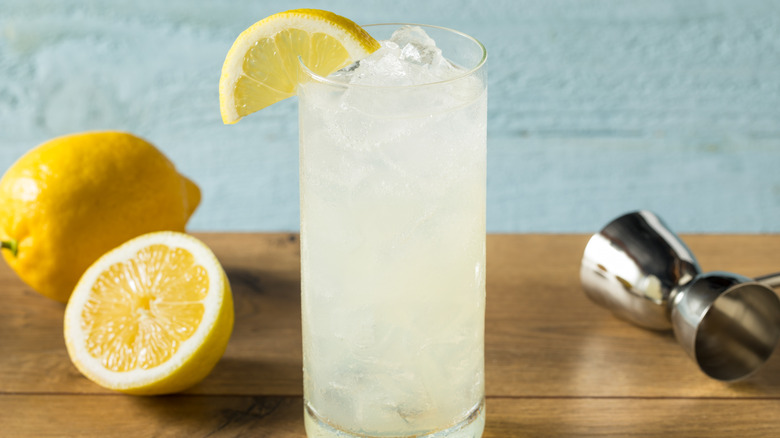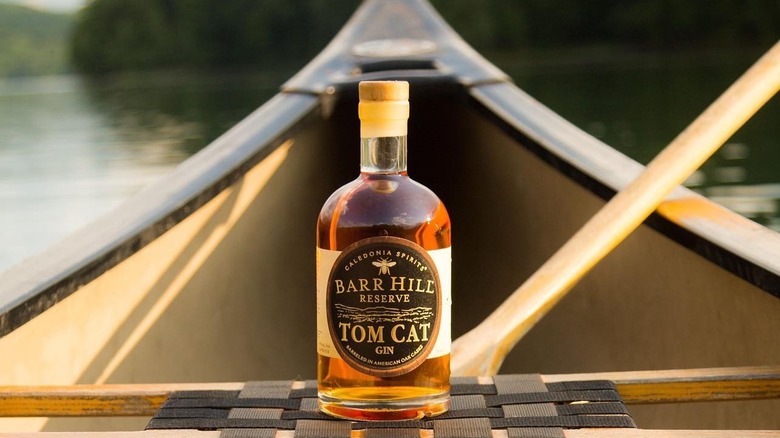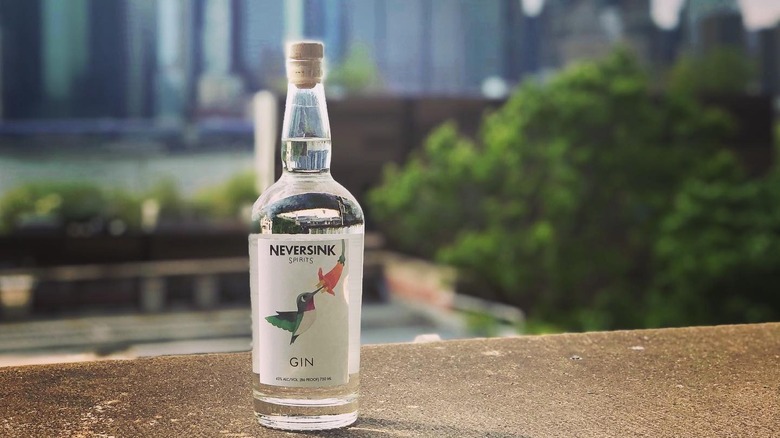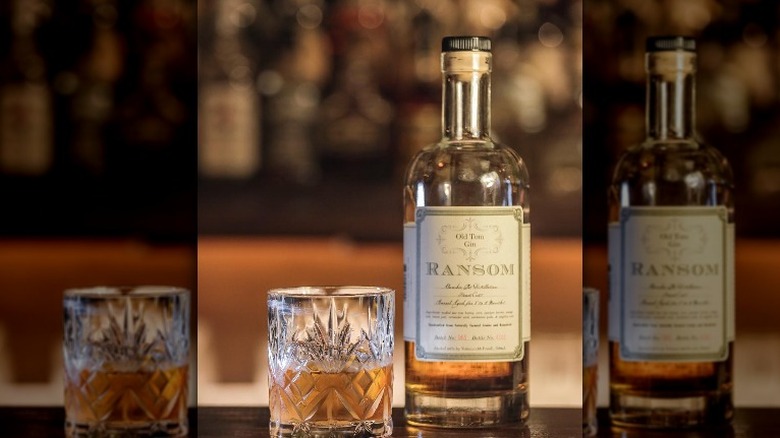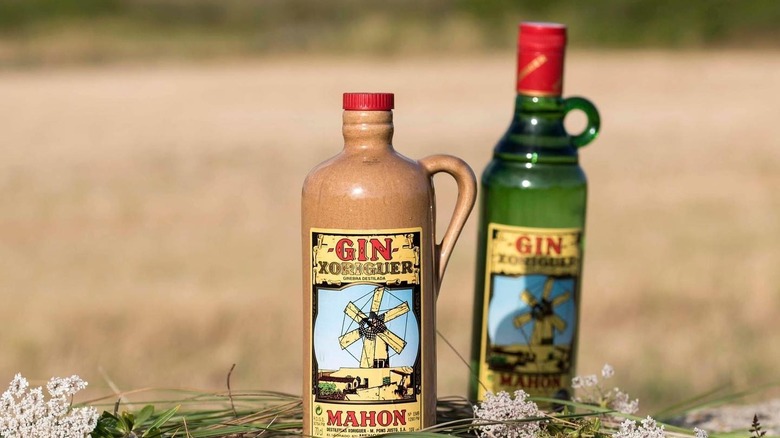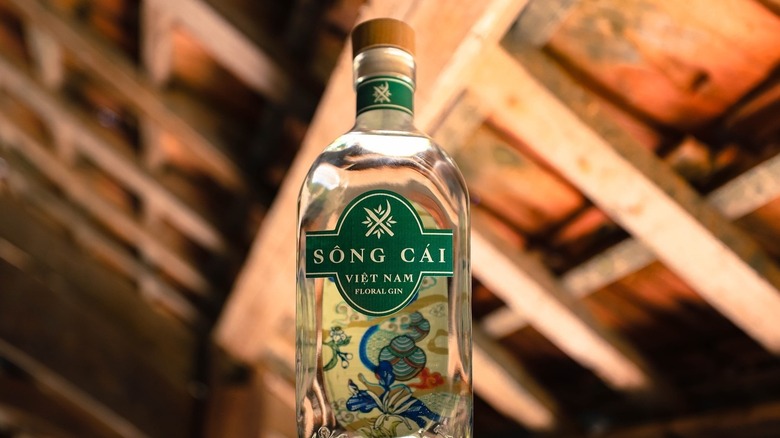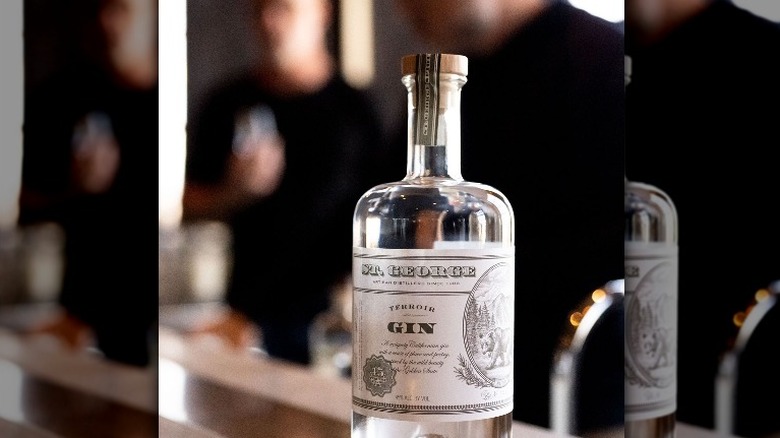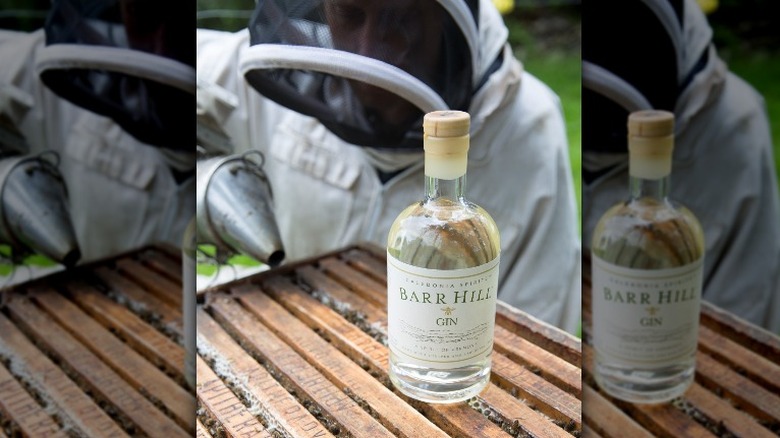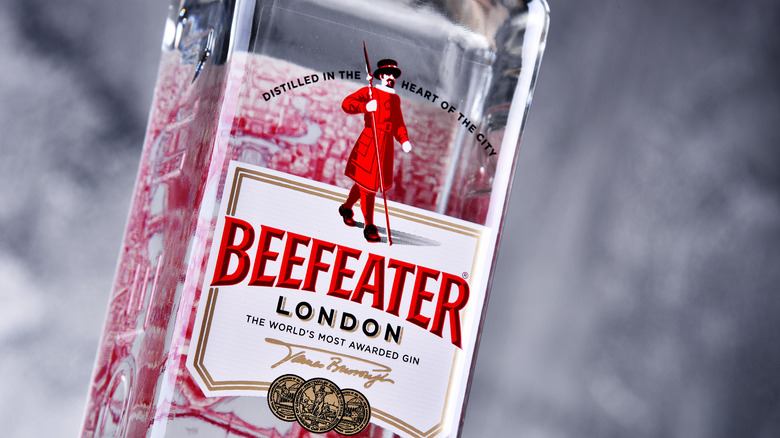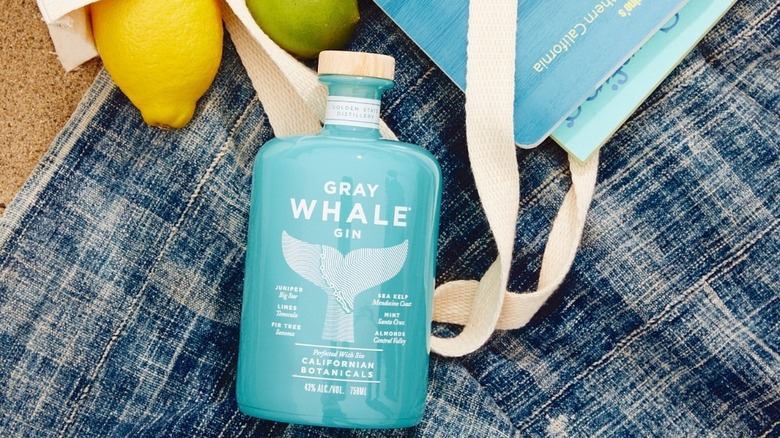10 Best Gins For A Tom Collins
Just a few simple ingredients are often all it takes to make a killer cocktail, and the Tom Collins is no exception. According to Liquor, the Tom Collins requires just four ingredients: gin, lemon juice, simple syrup, and club soda. The refreshing concoction has its roots in the gin punches popular among 19th century London drinkers, and the story goes that a bartender named John Collins named the cocktail for himself — though there's no way for us to know whether he really invented the thing. Eventually, thanks to the Old Tom gin its recipe required, over time the "John Collins" became a "Tom Collins."
The New York Times claims that Old Tom and London Dry gin styles will work equally well, but there are differences of opinion about what a Tom Collins really is, and how it should really be made. So we sat down with three experts of the liquor trade to talk gin and see what we could come up with.
Ryan Polhemus it the Bar Manager at Offsuit, a speakeasy cocktail bar in Boston's Leather district. Mattie Hanson is the Spirits Director at the award-winning wine + spirits shop Stanley's Wet Goods in Los Angeles. And Ted Kilpatrick is the co-founder and owner of Chickadee, a James Beard semi-finalist for Best New Restaurant. Kilpatrick is also the mind behind the so-clever-how-hasn't-it-been-done-yet Kilpatrick Strainer. We chatted with all three to figure out what their favorite gins for a Tom Collins are and why.
Barr Hill Tom Cat
Barr Hill Tom Cat Gin is a mouth-watering and unique gin. The Vermont-based distillers and beekeepers start by distilling their Barr Hill gin with juniper and then finishing with raw honey. After distillation, the regular Barr Hill is aged in new American oak barrels and becomes something entirely different: the Tom Cat. The aging process imparts secondary flavors and a darker color to the spirit, making it fall somewhere between whiskey and gin on the flavor spectrum.
"The technical right answer [to the question of what gin goes in a Tom Collins] is that it should be made with an Old Tom gin, hence the name," says Kilpatrick. According to Tales of the Cocktail, Old Tom is a style of gin slightly sweeter and less botanical than a traditional London Dry or other, more popular, modern gins on the market. Though Kilpatrick maintains that a strictly traditional Tom Cat style is the correct answer, he likes the idea of Barr Hill for a Collins because it's distilled with, and then sweetened with, honey. "If you want something a little off the beaten path for a Tom Cat, that would be Barr Hill's Tom Cat Gin," he notes. A traditionally made Tom Collins that bucks tradition — we like it.
Neversink
Neversink Spirits is the passion project of two friends, Noah Braunstein and Yoni Rabino. Based in upstate New York, the distillery makes all sorts of stuff — brandies, bourbons, aperitifs — but Neversink Gin is their flagship spirit. The gin is produced using a base apple spirit that's then macerated with juniper overnight, says Mattie Hanson, and further distilled through eleven botanicals including more juniper, citrus peel, roots, and spices.
Hanson also notes that Neversink works so well in a Tom Collins because its apple spirit base gives it a rounder, fruitier profile than many other gins. "That sort of profile plays nicely with the lemon in a Tom Collins, and actually allows you to use a little less sugar," says Hanson. The gin's fruity aromatics trick your nose and palate into thinking the spirit is sweeter than it is, allowing for a softer touch on the simple syrup component of the Tom Collins. "Any excuse to ease back on the added sugar in a drink is a good one for me."
Ransom Old Tom
Perhaps the most "correct" Tom Collins gin on this list, Ransom Old Tom markets itself as a historically accurate revival of 19th-century gins and boasts of being the first American Old Tom style to be released after Prohibition's end. Ryan Polhemus points to Ransom as his first go-to if you're looking for a classic Tom Collins, "The Old Tom style is a whiskey drinker's gin, and this barrel-aged, slightly sweeter style strays from the London Dry juniper bombs."
As far as what a Tom Collins should be — if you're playing by the historical rules, at least — Polhemus says Ransom Old Tom can't be beaten. Its time spent in the barrel lends it that same dark color enjoyed by Barr Hill's Tom Cat, and the inclusion of Ransom in your Tom Collins will lend the drink a caramel color and woodsy flavor not to be missed. Think of this one as an end-of-summer Collins, if you will.
Mahón
Mahón Gin is made on the Spanish island of Menorca and is named for the island's port city of Mahón. In the early 1700s, the city became home to a British naval base, and it is from the introduction of British drinking culture that the island's love for its own gin blossomed. Mahón's recipe was a quick hit among British soldiers and locals alike, with the "Mahón Gin Recipe" becoming known by the mid-1700s for its superior smoothness. Fast forward a couple of hundred years, and now it's one of Polhemus's favorite gins in general — but especially for a Tom Collins.
"It's distilled from wine, and the grape-based spirit lends the gin certain fruity notes that'll go well with whatever citrus you want to throw at it," Polhemus notes. A Tom Collins works, or you can try it with any other number of citrus-forward gin cocktails, like a Salty Dog or a gimlet.
Tanqueray No. 10
Tanqueray No. 10 is a burst of citrus flavor, a bright alternative to the darker style gins like Barr Hill or Ransom, and a warm-weather Collins gin if we've ever heard of one. Drink Spirits reports that the name — contrary to popular belief — has nothing to do with the number of botanicals used in distillation. In fact, it gets the No. 10 moniker from the 10th still that it was initially produced in at the Tanqueray facility. The number of botanicals isn't 10, but eight: The base of four that is found in normal Tanqueray, plus whole fresh citruses like lime and grapefruit.
Juniper and citrus are certainly the stars of the show in this gin, and Polhemus thinks it's a no-brainer for a Tom Collins, "This extra-indulgent gin adds bright citrus notes to the standard botanicals in Tanqueray, giving you more flavor to work with. It's great in a martini, a classic G&T, or something bright and fizzy like a Tom Collins." We'll take all three, thank you very much.
Sông Cái
It's not often you ask around and someone recommends a Vietnamese gin for your next Tom Collins. But that's just what Mattie Hanson is wild about right now, "Sông Cái is made by first-generation Vietnamese-American Daniel Nguyen," Hanson says. "But he's working with farmers and families in Vietnam itself to distill the country's first-ever gin." Nguyen's goal, according to the gin's website, is to give local communities a reason to preserve native plants, botanicals, and heirloom grains while economically bolstering everyone involved in the Sông Cái project.
Hanson points out that all 16 of the gin's botanicals are sourced locally in Vietnam, giving the spirit what he refers to as an "extremely clear sense of terroir, and a distinct personality." Apart from its cool origin story, what makes it perfect for a Tom Collins specifically? "The spice of jungle pepper and cardamom," Hanson says. "They come out to party and make for a one-of-a-kind Tom Collins." Alright, then. Party on.
St. George Terroir
California darling St. George Spirits has its hands in just about every spirit nowadays, but the Terroir Gin is one of the clear winners among the vast lineup. "It's as American as apple pie," says Polhemus. "But it's not made from apples," he quickly adds.
This gin is distilled with a dozen California botanicals, including Douglas fir and California bay laurel. That duo composes what St. George Spirits describes as the gin's aromatic signature. "They set out to craft a gin with a sense of place," says Polhemus, referring both to the distillation's process and the bottle's name.
For those who might not know, 'terroir' is a wine term — borrowed, in this context, by a spirits producer — which refers to a region's climate, terrain, and other environmental factors that influence how a product from that region tastes. Polhemus notes, "The California botanicals really come through, and it makes for a woodsy, piney Tom Collins that never disappoints." But he cautions playing the recipe too safe if you're using this gin. Try laying off the simple syrup a bit and switching up the garnish. Also, lose the citrus and try something more herbal.
Barr Hill
No, no — not the Tom Cat. Whereas Kilpatrick went with Barr Hill's Tom Cat gin, Hanson skipped the dark stuff and voted for Barr Hill's regular gin. "They ferment with sustainably harvested honey from their own farms," says Hanson. "This gives their stuff a rich, floral quality that's uniquely its own, and everyone knows honey and lemon go perfectly together." His argument: While Tom Cat is technically the more traditional gin to make a Tom Collins, the cocktail itself has earned a reputation for being fresher and lighter on its feet than a barrel-aged gin might provide.
Gin enthusiasts at Good Gin-tentions also point out that though Bar Hill Gin is incredibly simple, using just the two botanicals of juniper and honey, it is also complex in its simplicity. Juniper remains fairly consistent season to season, yes, but the honey in it takes on different characteristics depending on which flowers the bees are surviving off of in a given year. Some of those nuances are liable to get lost after barrel aging. That makes this gin fairly good case for this as an alternative to the Barr Hill Tom Cat for your next Tom Collins.
Beefeater
Beefeater Gin won't win you any awards among your friends for originality, but as the world's most awarded gin, that doesn't really matter. There's a reason this stuff is everywhere — because it's good. Beefeater is a true London dry-style gin, distilled in London with nine botanicals and showcasing the classic juniper-meets-citrus flavor profile that makes London dry such a popular mainstay.
Ted Kilpatrick offers Beefeater as an option for what your average drinker is looking for when they order a Collins. "This makes a much more ubiquitous and straightforward style of Tom Collins," he says. "If I'm looking for a nice backbone London dry style, I always reach for Beefeater." He pauses, "Citadelle works, too." Beefeater doesn't have the woodsy or more botanical nuance of some of the more unusual gins on this list, but it plays well with lemon, soda, and sugar. And that's really what a Tom Collins is all about.
Gray Whale
Another California darling, Gray Whale gin is a six-times distilled corn base gin that uses six botanicals before its seventh and final distillation. All botanicals are sourced in California and include standard choices like juniper and mint while incorporating off-the-wall additions like kombu (a type of algae) and, get this, almonds.
"Gray Whale is a Swiss Army knife," says Hanson. You can use it in martinis, G&Ts, Collinses, you name it. Their website provides no shortage of bespoke branded drink ideas, or you can employ it as a base in any number of bright, summery gin cocktails. But the reason Hanson chose this gin for a Tom Collins specifically? "It's sort of a party trick, just like the Tom Collins. You pull out this really cute blue bottle and people immediately want to know what it is, where it's from. Same with the Collins — you make a round and people want to know 'what is this delicious spiked lemonade? Could it really be that easy?'" Next time you see the blue bottle, pick one up. You won't be disappointed.
